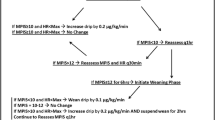Summary
Despite advancing knowledge of the pathophysiology and treatment of asthma, asthma mortality is not reduced. Patients with severe asthma exacerbations develop progressive airflow obstruction over hours to days as a result of airway wall inflammation, bronchospasm and intraluminal mucus. Airflow obstruction causes ventilation-perfusion inequality, lung hyperinflation, and increased work of breathing. Severe cases are characterized by an inability to speak, diaphoresis, pulsus paradoxus, accessory muscle use, low peak expiratory flow rate, and a rising partial pressure of carbon dioxide. Inhaled beta-agonists, theophylline, systemic corticosteroids, and oxygen remain the drugs of choice in severe asthma exacerbations. Anticholinergics play a lesser role in the treatment of acute asthma. Available data do not support the routine use of ketamine, magnesium sulfate, heliox or antibiotics in patients with severe asthma exacerbations. For now, bronchoscopy with BAL should not be considered a part of the routine management of asthmatics. Patients failing drug therapy should be considered early for noninvasive ventilation or intubation and mechanical ventilation. Noninvasive positive pressure ventilation are promising adjuncts to the treatment of nonintubated patients. A strategy of mechanical ventilation including limition of minute ventilation, decreasing inspiratory peak pressure, and tolerating hypercapnia, avoids excessive lung hyperinflation and barotrauma. Indirect evidence suggests that this approach to mechanical ventilation in acute severe asthma decreases morbidity and mortality; however, the key to the management of this disease (which in many cases represents a failure of outpatient management) is patient education and disease prevention.
Zusammenfassung
Trotz gewachsenem Wissen über Pathophysiologie und Therapie des Asthmas wurde die Mortalität bisher nicht reduziert. Bei Patienten im Asthmaanfall kommt es zur fortschreitenden Atemwegsobstruktion, die stunden- oder tagelang anhalten kann und Folge von Entzündung der Atemwege, Bronchospasmus oder Schleimansammlungen im Lumen ist. Die Atemwegsobstruktion führt zu Ventilations-Perfusions-Inhomogenitäten, Hyperinflation und vermehrter Atemarbeit. Typisch für schwere Fälle ist die Unfähigkeit zu sprechen, Schwitzen, Pulsus paradoxus, Einsatz der Atemhilfsmuskulatur, eine niedrige maximale exspiratorische Atemflußrate und ein Anstieg des Kohlendioxidpartialdrucks. Inhalative β 2-Sympathomimetika, Theophyllin, systemisch Kortikosteroide und Sauerstoff sind die Therapie der Wahl. Anticholinergika spielen eine untergeordnete Rolle in der Therapie des Asthmaanfalls. Zu den Medikamenten mit umstrittener Wirksamkeit zählen Ketamin, Magnesiumsulfat, Heliox und Antibiotika. Die Bronchoskopie mit bronchoalveolärer Lavage kann bisher nicht als Routinemethode in der Behandlung der Asthmatiker angesehen werden. Bei Patienten, die auf die medikamentöse Therapie nicht ansprechen, sollte frühzeitig an die nicht-invasive Beatmung oder Intubation und maschinelle Beatmung gedacht werden. Die nicht-invasive Beatmung gehört zu den vielversprechenden Methoden bei der Behandlung nicht intubierter Patienten. Als Beatmungsstrategie
Similar content being viewed by others
Author information
Authors and Affiliations
Additional information
Eingegangen: 15. Januar 1999 Akzeptiert: 2. Februar 1999
Rights and permissions
About this article
Cite this article
Meissner, E. Schwerer Asthma bronchiale-Anfall. Intensivmed 36, 145–155 (1999). https://doi.org/10.1007/s003900050221
Issue Date:
DOI: https://doi.org/10.1007/s003900050221




